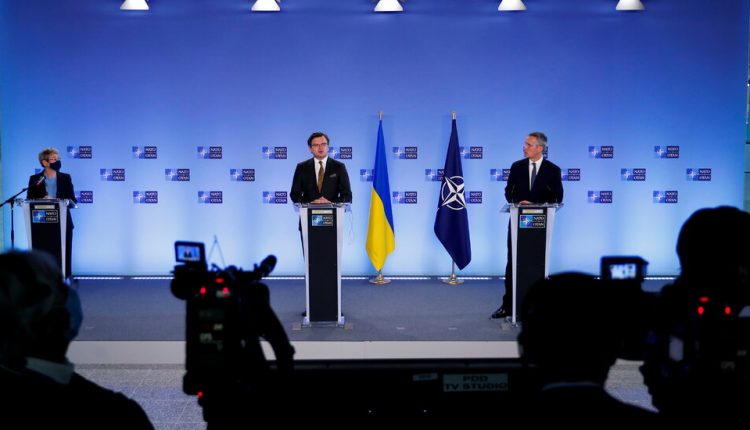US signals support for Ukraine, says will add troops in Germany
By Steven Erlanger, Melissa Eddy and Helene Cooper
BRUSSELS — The United States and NATO, anxious about a major Russian troop build-up on Ukraine’s border, signalled strong support for the Kyiv government Tuesday (13).
And in what was considered another message to Moscow, Defence Secretary Lloyd Austin said in Germany the United States would increase its military presence there by about 500 personnel and that it was scuttling plans introduced under President Donald Trump for a large troop reduction in Europe.
The moves come as US and European officials have grown increasingly concerned about Moscow’s deployment of additional troops near the Ukraine border, more than at any time since Russia’s annexation of Crimea in 2014, in violation of international law. Since then, Russian troops have been engaged in fomenting a separatist movement in eastern Ukraine and consolidating their hold on Crimea.
The message regarding Kyiv was delivered in separate meetings in Brussels with Ukraine’s foreign minister, Dmytro Kuleba.
“The US stands firmly behind the sovereignty and the territorial integrity of Ukraine,” Secretary of State Antony Blinken told Kuleba. NATO’s secretary-general, Jens Stoltenberg, said “Russia must end this military build-up in and around Ukraine, stop its provocations and de-escalate immediately.”
Blinken and Austin will meet at NATO headquarters in Brussels on Wednesday (14) for an emergency gathering of all NATO foreign and defence ministers — partly virtual — to discuss how to further support Ukraine.
“This meeting is extremely timely given what is happening along the Ukrainian border with Russia,” Kuleba said, calling it the “border of the democratic world.”
The increase in US troops in Germany is a strong indication of the Biden administration’s commitment to NATO and to collective European defence. Coupled with President Joe Biden’s harsh words about President Vladimir Putin of Russia, the expansion of US troops and the reversal of Trump’s plans to withdraw up to 12,000 of the roughly 36,000 stationed in Germany will not go unnoticed in the Kremlin.
“These forces will strengthen deterrence and defence in Europe,” Austin said after meeting his German counterpart, Annegret Kramp-Karrenbauer. “They will augment our existing abilities to prevent conflict and, if necessary, fight and win.”
The change “will greatly improve our ability to surge forces at a moment’s notice to defend our allies,” Austin said. He did not elaborate on the added troops’ specific mission, saying only that the change would “create more space, more cyber and more electronic warfare capabilities in Europe.”
One of the two new units will involve field artillery, composite air and missile defence, intelligence, cyberspace, electronic warfare, aviation and a brigade support element. The other will be a command to improve the way that countries cooperate during joint operations, the army said in a statement.
The new units will be stationed in Wiesbaden, the headquarters of the US Army Europe.
“In recent weeks, Russia has moved thousands of combat-ready troops to Ukraine’s borders, the largest massing of Russian troops since the illegal annexation of Crimea in 2014,” Stoltenberg of NATO said, echoing a statement last week from the White House press secretary, Jen Psaki, who called the Russian actions “deeply concerning.”
Pentagon officials say privately that they do not think Moscow is on the verge of an invasion, but concerns have mounted within the Biden administration.
On Tuesday, Biden and Putin spoke on the phone for the first time since Biden last month assented to a description of Putin as a “killer” during an interview, which sparked a furious reaction in Russia.
According to a White House summary of the call, Biden expressed concern over the Russian military build-up near Ukraine, and called on Putin to de-escalate tensions. A more terse Kremlin summary of the conversation referred to “an internal Ukrainian crisis,” without mentioning a troop build-up.
But Sergei Shoigu, Russia’s defence minister, said Tuesday that “two armies and three airborne units were successfully deployed to the western borders of Russia” over the past three weeks “in response to NATO military activities that threaten Russia.”
He added: “The troops have shown full readiness and ability to fulfil tasks to ensure the country’s military security. At present, these formations and divisions are involved in exercises.”
Russian officials have also hinted at a desire to protect Russian citizens in eastern Ukraine.
Russia is widely seen as testing Biden and keeping the pressure on Ukraine’s president, Volodymyr Zelensky, who has moved against some of the Kremlin’s favourite oligarchs.
Ian Bond, a former British diplomat who is head of foreign policy for the Centre for European Reform, said that a war was unlikely now but could come this summer. He wrote in a briefing paper that Russian analysts were suggesting that the ground in eastern Ukraine would be too wet for armor for another month, and that the helicopters and aircraft needed for an airborne assault were still absent from Crimea — signs that no attack is imminent.
The Kremlin could also be trying to pressure Europeans to persuade Zelensky to make diplomatic concessions, like allowing Russian troops to put forces along the “line of contact” between the two sides as peacekeepers, Bond suggested.
In any event, Bond said, the United States and NATO should both reassure Ukraine and “deter Russia by shifting the cost-benefit calculation in favor of de-escalation” — in particular by being clear to Moscow about what the consequences of a new military intervention would be.
Kuleba seemed to agree.
“At the operational level, we need measures which will deter Russia and which will contain its aggressive intentions,” he said Tuesday, suggesting “a new round of sanctions which would raise the price of Russian aggression.”
-New York Times


